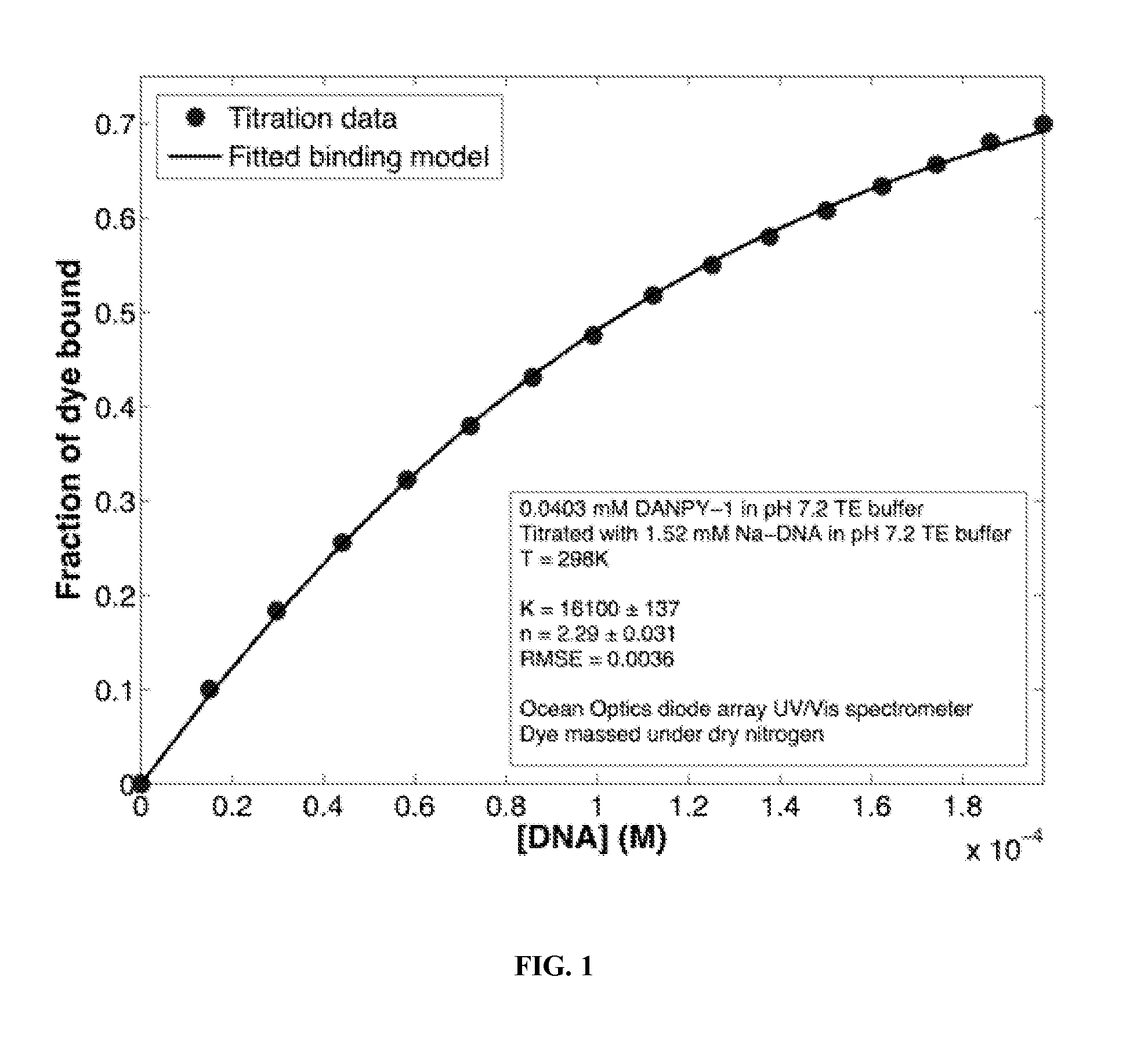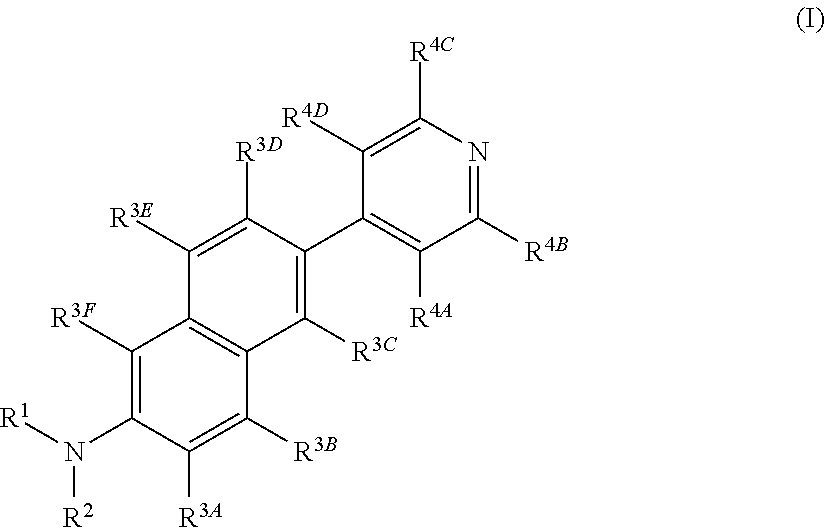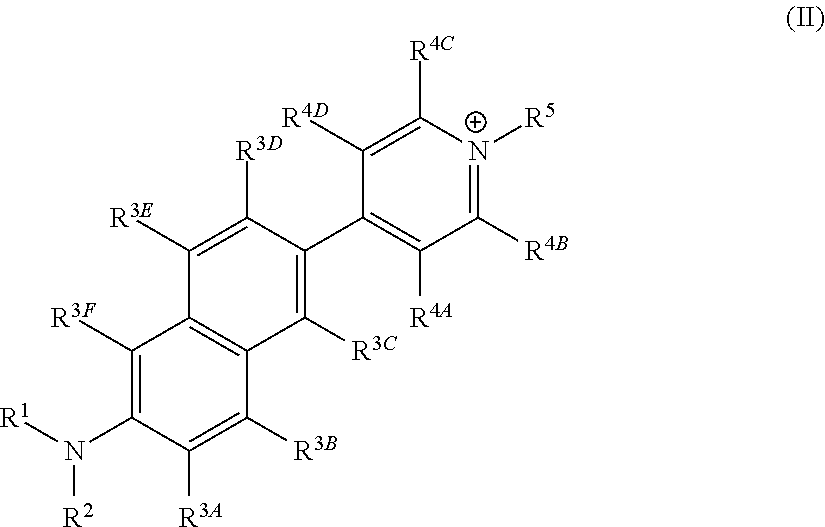Fluorescent Dyes and Related Methods
a technology of fluorescence dyes and dyes, applied in the field of fluorescence dyes, can solve the problems of reducing the use of fluorescent molecules with an affinity for dna as effective dyes for dna detection, and affecting the detection accuracy of fluorescent molecules
- Summary
- Abstract
- Description
- Claims
- Application Information
AI Technical Summary
Benefits of technology
Problems solved by technology
Method used
Image
Examples
example 1
[0072]Electro-optic devices based on organic materials typically use small-molecule dyes embedded within a host polymer, typically a common engineering polymer such as poly(methyl methacrylate) (PMMA) or amorphous polycarbonate (APC). However, biopolymers such as DNA can also be used as a host matrix when coated with surfactants such as CTMA (cetyl trimethylammonium chloride) or CTAB (cetyl triethylammonium bromide) to allow processing with common organic solvents. Such DNA-surfactant complexes possess several favorable properties, including an ordered local structure, low optical loss, and a tunable refractive index. They are also inexpensive to manufacture; as bulk DNA can be easily obtained from fisheries waste.
[0073]CTMA-DNA has also been used as a cladding layer in modulators developed with conventional guest-host organic glasses. (Grote, J. G. et al.; J. Phys. Chem. B 2004, 108 (25), 8585-8591.) Functioning electro-optic waveguide modulators have been demonstrated, using Dispe...
example 2
[0090]This example describes affinity of DANPY-1 to DNA. The affinity of DANPY-1 was compared to the common intercalating dye ethidium bromide by means of photometric titrations with DNA in aqueous buffer. The wavelength undergoing the largest absorption change (467 nm for ethidium bromide, 391 nm for DANPY-1) was used for determining the fraction of dye bound. An aqueous environment was chosen due to the observed lack of substantial binding between ethidium bromide and CTAB-DNA and concerns about difficulty in penetrating the tightly bound surfactant layer. These experiments were analyzed using the Scatchard equation (Scatchard, G., Ann. N. Y. Acad. Sci. 1949, 51, 662-672.)
r[DNA]=nK-rK(1)
where r is the ratio of bound dye to total DNA (bound or unbound), n is the number of binding sites occupied per base pair, and K is the binding constant. The concentration of DANPY used was substantially lower due to its higher extinction coefficient, and both runs only considered the region where...
example 3
[0108]In addition to the in vitro experiments mentioned above, LL-1 (or DANPY-1) was also evaluated in living cells as a stain for fluorescence microscopy applications. When dissolved in DMSO, it proved capable of crossing the cell membrane of Gymnodinium sp and accumulating in the nucleus, where it fluoresced yellow when excited by light in the 450-490 nm range. (data not shown)
[0109]In another aspect, this example describes a set of experiments to investigate DANPY-1 dye for use in flow cytometric analysis of DNA. The alga Prorocentrum minimum was selected for these studies. Several controls were run to: (a) ensure that cell integrity was maintained, (b) assess the contribution of unbound DANPY-1 to fluorescent background signals and (c) determine a dye concentration and the intensity of the fluorescent signal when the target DNA is fully saturated with bound dye. The DANPY-1 concentrations that were tested in these preliminary experiments ranged from 7.1 μM to 228 μM. All of the ...
PUM
| Property | Measurement | Unit |
|---|---|---|
| Fluorescence | aaaaa | aaaaa |
Abstract
Description
Claims
Application Information
 Login to View More
Login to View More - R&D
- Intellectual Property
- Life Sciences
- Materials
- Tech Scout
- Unparalleled Data Quality
- Higher Quality Content
- 60% Fewer Hallucinations
Browse by: Latest US Patents, China's latest patents, Technical Efficacy Thesaurus, Application Domain, Technology Topic, Popular Technical Reports.
© 2025 PatSnap. All rights reserved.Legal|Privacy policy|Modern Slavery Act Transparency Statement|Sitemap|About US| Contact US: help@patsnap.com



